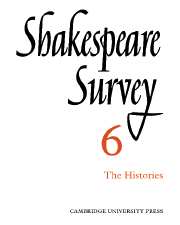Book contents
- Frontmatter
- Shakespeare's History plays: 1900-1951
- The Unity of 2 Henry IV
- Anticipation and Foreboding in Shakespeare’s Early Histories
- Middle-Class Attitudes in Shakespeare’s Histories
- A Reconsideration of Edward III
- On Producing Henry VI
- The Huntington Library
- An Early Elizabethan Playhouse
- Shakespeare Learns the Value of Money: The Dramatist at Work on Timon of Athens
- Shakespeare’s French Fruits
- An Elizabethan Eyewitness of Antony and Cleopatra?
- Othello’s “It is the cause . . .”: An Analysis
- On Translating Hamlet
- Shakespeare in China
- International Notes
- Shakespeare Productions in the United Kingdom: 1951
- Shakespeare’s History Plays - Epic or Drama?
- Festival Shakespeare in the West End
- The Year's Contributions to Shakespearian Study 1 Critical Studies
- 2 Shakespeare’s Life, Times and Stage
- 3 Textual Studies
- Books Received
- Index
- Plate Section
The Unity of 2 Henry IV
Published online by Cambridge University Press: 28 March 2007
- Frontmatter
- Shakespeare's History plays: 1900-1951
- The Unity of 2 Henry IV
- Anticipation and Foreboding in Shakespeare’s Early Histories
- Middle-Class Attitudes in Shakespeare’s Histories
- A Reconsideration of Edward III
- On Producing Henry VI
- The Huntington Library
- An Early Elizabethan Playhouse
- Shakespeare Learns the Value of Money: The Dramatist at Work on Timon of Athens
- Shakespeare’s French Fruits
- An Elizabethan Eyewitness of Antony and Cleopatra?
- Othello’s “It is the cause . . .”: An Analysis
- On Translating Hamlet
- Shakespeare in China
- International Notes
- Shakespeare Productions in the United Kingdom: 1951
- Shakespeare’s History Plays - Epic or Drama?
- Festival Shakespeare in the West End
- The Year's Contributions to Shakespearian Study 1 Critical Studies
- 2 Shakespeare’s Life, Times and Stage
- 3 Textual Studies
- Books Received
- Index
- Plate Section
Summary
It should perhaps be made clear that this is not a contribution to the debate on Shakespeare’s original planning of the Prince Henry plays. It has been argued by Dover Wilson in The Fortunes of Falstaff and in his New Cambridge edition, and by E. M. W. Tillyard in Shakespeare’s History Plays, that the two parts of Henry IV constitute one long play, envisaged at least in its main outlines from the very beginning of Part I. M. A. Shaaber, on the other hand, has put a case for regarding Part II as a sequel, outside Shakespeare’s original plan, brought into being through the remarkable success of Part I. Whichever of these views is correct, it is possible for Part II to have its own characteristic mood and structure, its separate dramatic impact, and my concern will be to demonstrate that this is indeed the case. The only assumption I shall make, which I think will be readily granted to me, is that Part II was written after Part I.
In writing the series of eight plays which give an outline of English history from the reign of Richard II to the accession of Henry VII, Shakespeare can hardly at the beginning have seen the scheme as a whole. If he had, it would be odd to start with the troubles of Henry VI. The mention of Prince Henry near the end of Richard II suggests it was then that Shakespeare began to think of plays in which he would be the central figure, plays which would close the gap between Bolingbroke's usurpation and the funeral of Henry V. But clearly the plays in the sequence already written had been markedly different from one another in structure and atmosphere.
- Type
- Chapter
- Information
- Shakespeare Survey , pp. 16 - 24Publisher: Cambridge University PressPrint publication year: 1953



